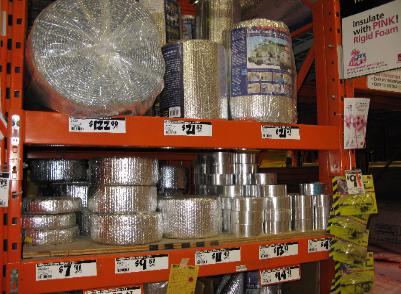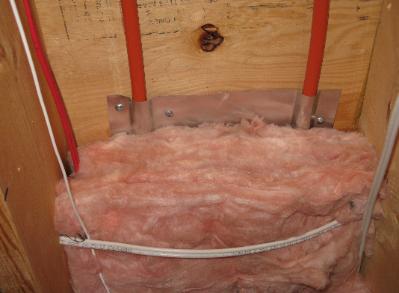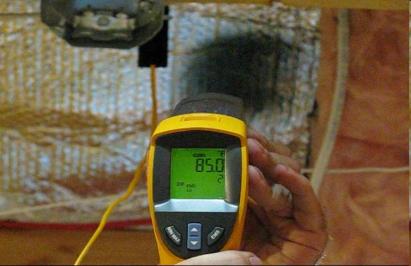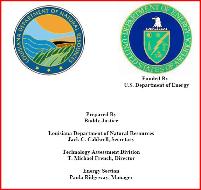- Home
- Deceptions
- Solar
- Thermal Audit
- Ventilation
- Sensors
- Governance
- Environment
- Reference
- Contact
- News
Foil covered bubble wrap
"radiant barrier" insulation products
Most large home improvement stores carry what looks like bubble wrap with a metallic foil covering. It is sold as an all purpose insulation and claims to be an effective "radiant barrier".

Using a radiant or hydronic floor (hot water heating under the floor), we can set up a
experiment as follows. In the picture below, taken in an unfinished basement looking up at the ceiling, you will see two orange pipes (not the red power line to the left) that carry hot water at 50C / 122F. There is an aluminum heat transfer plate that conducts heat from the pipes to the plywood floor. Normally, you would insulate it all with fiberglass.

Instead, we will set it up with half fiberglass, and half "radiant barrier" and use a FLUKE infrared thermometer to check the surface temperatures of the bubble wrap and the fiber glass. The fiberglass is in contact with the heat transfer plate. The bubble wrap is separated from it by about half an inch. To compensate for the reflectivity of the foil, we used the low emissivity setting on the infrared thermometer, and also tried some black spray paint. Both techniques work to get an accurate surface temperature reading on the shiny surface of the bubble wrap/foil product.

However, there is something not right here. That 85F reading is ten degrees higher than the (R-12/RSI 2) fiberglass insulation beside it. It will simply heat up the air space between the joists and convection (hot air currents) will transfer lots of heat to the basement ceiling. Furthermore, any benefit from the reflective service will be reduced as dust settles on the shiny surface.
If you look through publicly-funded research papers (excluding companies that manufacture, market and sell these products for obvious reasons), you will find that foil/air-bubble is a poor substitute for conventional insulations like fiberglass. For example:
Canadian Construction Material Center - National Research Council of Canada CCMC evaluates thermal resistance of low emissivity sheet material
In this study they created a wall as in the diagram below, which had an extra layer of bubble/foil separated by airspaces, and tested the insulation qualities of the wall.

"Evaluation findings - effective R-value of this material in combination with the air spaces and the strapping material (furring) used to create the air spaces will account for about 26% of the thermal resistance of the wall, whereas the low emissivity material itself will account for only about 5% .”
In the next study, under slab (cement floor) insulating materials were tested, including bubble pack insulation.

Canadian Mortgage and Housing Corporation - Comparison of Under-Floor Insulation Systems Comparison of Under-Floor Insulation Systems
Conclusion - "bubble-pack insulation had a low insulating value compared to the polyurethane panels and the XPS board. It’s cost benefit was the poorest of all insulating materials tested.
Insulation Comparison Demonstration - Louisiana Department of Natural Resources
Building Insulation Demonstration

Winter Conditions Power Requirements (lower is better)
"in Louisiana. We compared the power required to maintain the same temperature conditions in three identically constructed structures."
Here is a great web site (non profit) called Health Heating that has a lot more on this topic. ..
|
